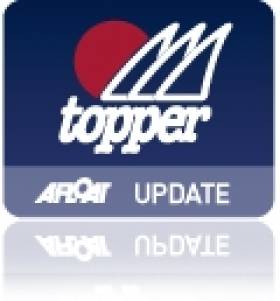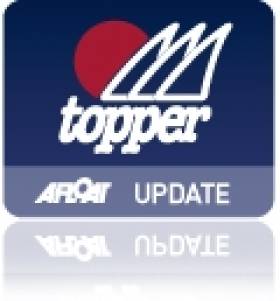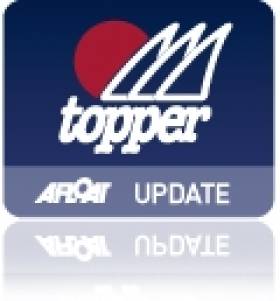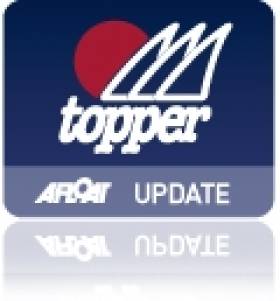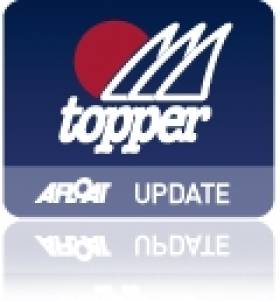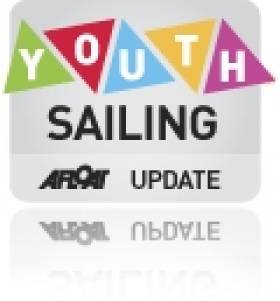Displaying items by tag: Topper
Hook Head Greets Topper Fleet with 30–knot Winds for Dunmore East National Championships
#toppersailing – After a series of mini heatwaves and windless weekends across the country in June the beginning of July brings a complete change for the Irish Topper Nationals in Waterford Harbour Sailing Club writes Gareth Craig.. Nearly sixty Toppers turned-out in Dunmore East from clubs across Ireland and the UK, and the three day event promises a variety of weather to suit the whole fleet.
Strong winds gusting over 30 knots off Hook head the night before the event were still making themselves felt as competitors registered, but the mood was jovial as the start was postponed a number of times - due to the wind at first, and then for safety reasons as the turning tide cause steep breaking waves across the proposed race area. Results to date are attached below for download.
By 1pm conditions had abated enough for the fleet to launch, with a South Westerly F4 (gusting F5) accompanied by intermittent driving drizzle providing enough power for the Toppers to ride the remaining infamous Dunmore Swell rolling up from the Celtic Sea. The uneven seas and fluctuating visibility made the windward mark hard to pick out at times, but this didn't appear to phase the fleet in any way as they powered away round the trapezoid course after one general recall. A top three of Niamh HARPER(Loch Tummel SC), Alexander HUGHES (Sutton SC) and Geoff POWER (Waterford Harbour SC) made good progress early, and gradually opened up leads on each other and the fleet at large, while the main body of competitor fought for places in tight bunches.
Winds and sea conditions had eased further by the second start, and again PRO Philip Cowman kept the Toppers in order, with just a single recall required despite a strong ebbing tide under the fleet propelling them up the beat. Those who had featured well in the first race largely failed to repeat their achievements, with the noted exception of Alexander HUGHES, and much of the top twenty were in a distinctly different order! This gives Hughes the overnight lead on 3 points, with a significant cushion over Ollie DIXON (Royal Harwich YC), Conor QUINN (Carlingford Lough YC), Niamh HARPER, and Adam DARCY (Royal Cork YC) tightly clumped on 10 or 11 point.
Forecasts are predicting the most contrasting day possible for Saturday, with rising pressure and light winds in the morning which will slowly build to F3-4 by early afternoon, and further light conditions for Sunday which could see very different sailors coming to the fore before everything is decided.
Quinn Out Sails 70 Toppers At RNIYC for Northern Honours
#topper – Carlingford's Conor Quinn has added the Northern Topper title to the Eastern title he won in May. The Louth single–hander outsailed 70 Toppers at Royal North of Ireland Yacht Club for the Ulster Championships 2014. Day one of the two day event saw the wind slowly filling in by 12 noon, allowing a very impressive fleet of Topper sailors to launch from the shores of Belfast Lough. By 3pm there was a perfect northerly breeze of twelve knots permitting the OD to complete three races. Full results below.
#topper – A strong performance from Carlingford Lough's Conor Quinn saw off a home club challenge for the Jelly Bean sponsored Leinster Topper title at the National Yacht Club on Sunday. Full results downloadable below as a pdf file.
Quinn counted a 2,2,(3.0) 3, 2 and a final race win to finish the six race series on ten nett points, seven points clear of the host club's Hugh Perrette in second overall. Perette's club mate Heather Spain was third on 19 points.
The 35–boat fleet had sailors from 17 different Irish yacht clubs, including Royal Cork who dominated last weekend's Laser youth nationals at Howth.
Topper Worlds 2014 at Pwllheli Get Sponsor
#topper – The International Topper Class Association and Clwb Hwylio Pwllheli Sailing Club have announced that local chandlery company, Firmhelm are supporting the World Championship 2014.
Over 700 sailors, coaches and their families are expected to visit Pwllheli for this championship that is to be held between August 8-15 2014.
Gareth Roberts, Events Manager, Clwb Hwylio Pwllheli Sailing Club said " The Topper World championship 2014 is our major international event in this year's sailing calendar and we will be offering our Top Welsh Welcome to competitors and families. Sailors will be racing on one of the best sailing waters in Britain, while families will have a chance to visit the many attractions of the Llyn and Snowdonia and experience our unique Welsh heritage and culture."
Jane Butterworth of Firmhelm Ltd says "Our daughter Chloe has been sailing a Topper competitively for the last four years and is a member of the RYA National Intermediate and Welsh National Squads, she is really looking forward to seeing all the Nations coming to her doorstep to compete for the International Topper Class Association World Championships 2014 and is keen to do well herself on her home waters in her last year in the Class.
Belfast Sailor Liam Glynn Wins Topper Worlds
#topper– Liam Glynn from Ballyholme Yacht Club on Belfast Lough has won the Topper world championships in Loctundy, Brittany, France today.
Racing was cancelled today so Liam remained top of the 102 boat fleet with a healthy 13–point lead. Prize giving is at 5p this evening.
Ireland also had three other top 20s with Niamh Doran 12th, Tom Purdon14th and Conor Sherriff 17th.
Liam packed in a tough training season winning silver at the Irish Youth Nationals on Lough Derg.
Liam got off to a solid start with four top 3 finishes in his first four races including two fleet wins. He won yet another race on Day 2 but even with the steady breeze of 12 knots, Liam had to overcome some difficult sea conditions. Commenting after racing on Wednesday Liam remarked "The wind was quite steady, but it was tricky to deal with waves and current at the starting line. Moreover beating to get the windward mark was one-sided, and tide wasn't helping".
The sailors then faced very light conditions yesterday with winds of only 8 to 9 knots in the morning then dropping to even less in the afternoon. Liam continued his dominance at the top of the fleet while trying to avoid useless risks, ultimately leaving him in pole position at the end of the penultimate day with a 13–point cushion. Commenting after racing Liam said "At the beginning I wasn't confident enough to take risks but now given the results I feel like trying some strategies out. But in any case I really stay concentrated on my sailing and I know that at the end of the day getting constant results is more effective than trying to win each leg.
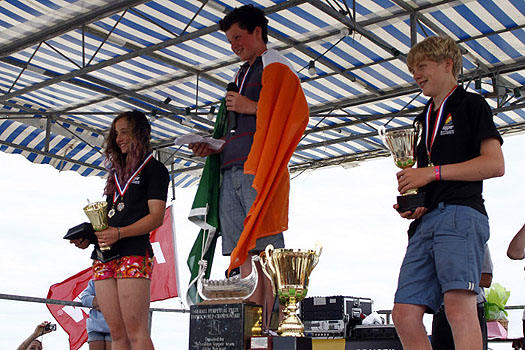
Draped in the tricolour, Liam Glynn from Belfast lough makes his acceptance speech at the Topper World Championship prizegiving

As for today the difficulty was to stay under the line with the current pushing you over but I managed and got good starts."
Topper is one of the most competitive youth classes with many Olympians having progressed through the ranks. Olympic sailor Ryan Seaton was once a star within the Topper ranks as well as Rio 2016 hopeful Philip Doran and ISAF youth silver medallist Finn Lynch the three only came close to claiming the world title which Liam now celebrates.
Northern Ireland Sailor Leads Topper Worlds in France
#topper – Liam Glynn from Ballyholme YC is leading the Topper World Championships in Loctudy, Brittany, France. In a fleet of 102 boats, he has already registered 3 firsts, 1 second and a third.
He has already won the Irish Nationals this summer at Donaghadee where conditions were similar with little breeze and lots of tide. Hopefully there is a little bit more wind forecast today although tomorrow is looking light without a sea or land breeze kicking in during the afternoon. Today is the first of the races where the gold and silver fleets have been separated and the racing starts properly. Ben Martin (BYC), Tom Purdon (BYC and SLYC), Peter Gilmore (SLYC), Lucy Mearns (SLYC) and Emily Hill (CAYC) should also make the Gold fleet.
Today wind-speed up to 12 knots , sunshine but also tidal stream were expecting the 117 contestants for the International Topper Class World Championship.
Racers were disturbed at the starting line by the tidal current as pointed out the young British William Birch Tomlinson who got the 4 th place for this evening.
"In the first and second race it was hard to stay under the starting line as the current made the dinghies drift.Then in the following legs everything was about taking the right decision and tack at the right moment to get the windward mark."
The Irish Liam Glynn, at the head of the overall results seems to share this point of view:
"The wind was quite steady but it was tricky to deal with waves and current at the starting line. Moreover beating to get the windward mark was one-sided and tide wasn't helping."
A light land breeze strengthened the wind-speed on the race and the real wind eventually dropped at midday. Then the land breeze had to vanish because of some clouds covering the body of water.
As for the French contestants, the process of learning how to sail this typically Anglo-saxon dinghy is still on the way.
"I never sailed a Topper before and I am far from the top ten but I don't really mind, Chloé Le Bars confesses. I usually sail Lasers and I'm not used to the Toppers' tricky balance. However I'm starting to get hold of this new boat even though what you feel when you hold the tiller is so different."
When we consider Marie-Anne Resmond the transition is even stiffer since she evolved from oppies to sporty catamarans. Hence a tough but pleasant return to single-handed dinghies .
"Going back to dinghies is so challenging, since you have to show real technical skills to sail them. I have so much to learn and to remember (many things forgotten when sailing catamarans) and I find it thrilling."
Tomorrow golden and silver fleet will be merged and that is when the real challenge to get in the top three starts.
Results after four races :
Topper 4.2 m² :
1. Hamish Beaumont (GBR), 14 pts ; 2. David Rosie, (GBR), 26 pts. ; 3. Georges Graham (GBR), 26 pts ; ... 15 classés.
Topper 5.3 m² :
1. Liam Glynn, (IRL), 25 pts ; 2. Phoebe Connellan ( GBR), 31 pts ; 3. Bella Fellows (GBR), 31 pts ; ... 102 classés.
Antrim Topper Sailor Starts Well at Tricky French Worlds
#Topper – A lack of wind made the fleet of 117 Toppers – including eleven Irish helms – wait all morning to finally reach the starting line at 13h30 yesterday at Cercle Nautique de Loctudy, France.
Ireland's best result came in the blue fleet when Emily Hill of County Antrim Yacht Club finished second.
Also competing for Ireland is Mark O'Conor and Conor and Eve Byrne of the National Yacht Club, Issy Delamer of Howth, Niamh Doran and Conor Sheriff of Courtown, Alison Dolan of Blessington, Liam Glynn of Ballyholme, Emma McKnight and Tom Purdon of Strangford Lough,
Because wind speed was not b enough to overcome tide, the racing committee could only launch the first legs of the race in the early afternoon.
The first legs of the day took place in a six to eight knots wind and lower at the end.In addition to that a powerful current , sometime overcoming the wind, worsened the already tricky conditions. Eventually,the committee members had to reduce the length between marks so that all the contestants could finish the race in time.
An hour later, time used to rearrange the marks for the new course, the Toppers went up on a second leg with more stable weather conditions but still very light wind. Within four to six knots, the fleet of 117 single-handed dinghies crossed the starting line but went no further.
The weather forecast for today is quite similar... competitors will have to wait until Wednesday to get a deserved constant twelve knots wind speed.
Results
Topper 4.2 (15 boats)
1. Millie Aldridge, GBR
2. Matthew Sanders, GBR
3. Lowri Boorman, GBR
Topper 5.3 (51 boats)
Yellow fleet:
1. Oliver Aldridge, GBR
2. Crispin Beaumont, GBR
3. Harriet Ward, GBR
Blue Fleet:
1. Elliot Kuzyk, GBR
2. Emily Hill, IRL
3. Peter Gillmore
Power Holds Lead at Waterford Topper Nationals
#topper – Waterford Harbour showed it's sunnier side for day two of the Irish National Topper Championships, with a similar breeze to yesterday giving more fantastic racing for the fleet but the strong currents continuing to complicate matters at mark roundings. Report and Photos (below) by Gareth Craig.
The race committee made the most of the perfect weather ahead of a relatively windless forecast for Sunday by packing in four races. The overnight top-two further consolidated their lead over the following pack with a string of good results pulling Dougie Power (WHSC) and Laura Gilmore (SLYC) clear in head-to-head for the overall lead. Multiple restarts were the order of the day as the fleet of nearly 50 youth sailors repeatedly egged each other on against the tide to force general recalls, and the dreaded black flag even made a number of appearances!
The wind gradually built through the day, blowing a good Force 3 – 4 by the later stages, and swinging a little between races, but staying from a north to north-westerly direction to keep the famous Dunmore Swell at bay for great Topper racing condition.
By the time the fleet came ashore with seven races complete and a single discard in play Power held the lead by three points from Gilmore, with Conor O'Farrell from Carlingford Lough YC 13 points further back in third and the rest of the top ten predominantly filled by sailors from along the east coast.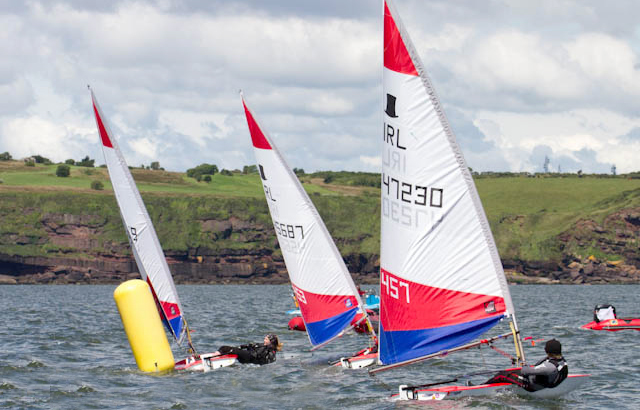
Large Topper fleet expected for Leinsters at Howth
#TOPPER – The Topper Leinster sailing Championships at Howth Yacht Club on March 31st/April 1st is the first event of the season for the Irish Topper class and with qualification for the ISA Topper Squad at stake, a competitive fleet of up to 40 boats is expected from clubs as far apart as Wexford and Antrim.
To qualify for the 2012 ISA Topper Squad sailors must compete in both the Leinsters in Howth and the Mitsubishi Youth Nationals in Dun Laoghaire in mid-April. The Topper squads are training groups formed, co-ordinated and managed by the ISA (and RYA in the North).
The ISA squad comes under the Olympic pathway which allows for progression from the junior fleet to the Olympic classes. The squad will be re-selected in April after the Youth sailing Championships and will prepare the sailors to compete in the 2012 Topper World Championships at Workum in Holland.
Friday 23rd March is the deadline for discounted entry fees of €50/£45 (after which they increase by €10/£10) for the Leinsters and entry is restricted to members of the Irish Topper Class Association.
The event, under the guidance of PRO Richard Kissane and his team, has a schedule of six races over the two days.
Youth Boat Selection Requires Leadership
There has been a call for the Irish Sailing Association (ISA) to take a lead in the big decisions that face youth sailors on what classes to sail to after they leave the ranks of the Optimist, Topper and Feva classes. The call comes from a leading junior organiser who does not wish to be named.
Although youth sailing is buoyant in Ireland it is known there is a 'high attrition rate' among teenagers. The lack of transfer in to senior dinghy classes has been a cause of concern for many clubs around the country.
The comments follow a recently published article on Afloat.ie promoting the RS 200 dinghy as a progression boat for juniors.
"We need a class that will keep youths engaged. The 420 and 29er are great boats but require higher levels of boathandling, are much more competitive and tend to attract the top sailors"
"While the ISA's Olympic ambitions are great to see, it will fail the sport as a whole if it does not tackle this gaping need, the organiser says.
Read the RS 200 article by Ciara Byrne and the junior organiser's comments here


























